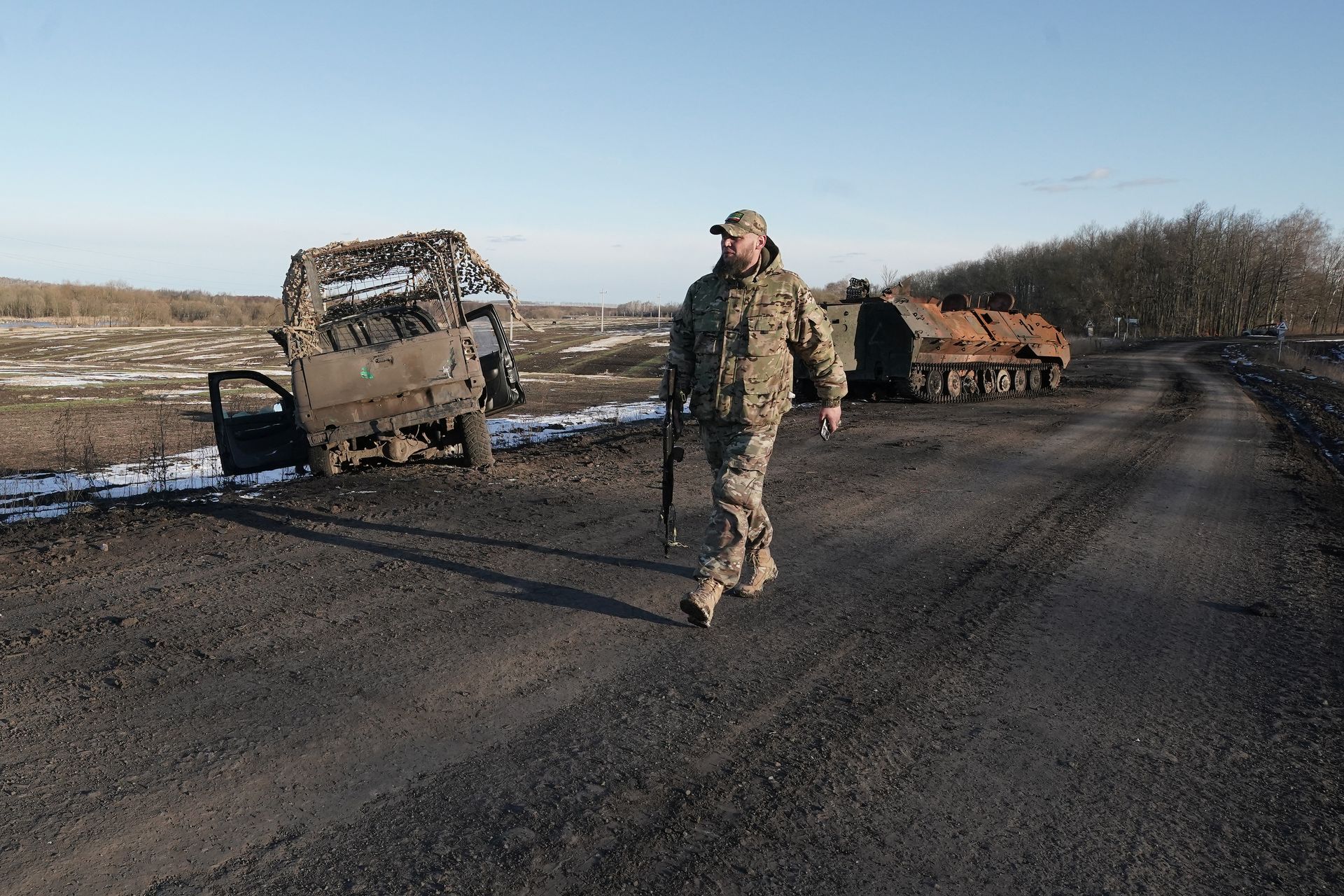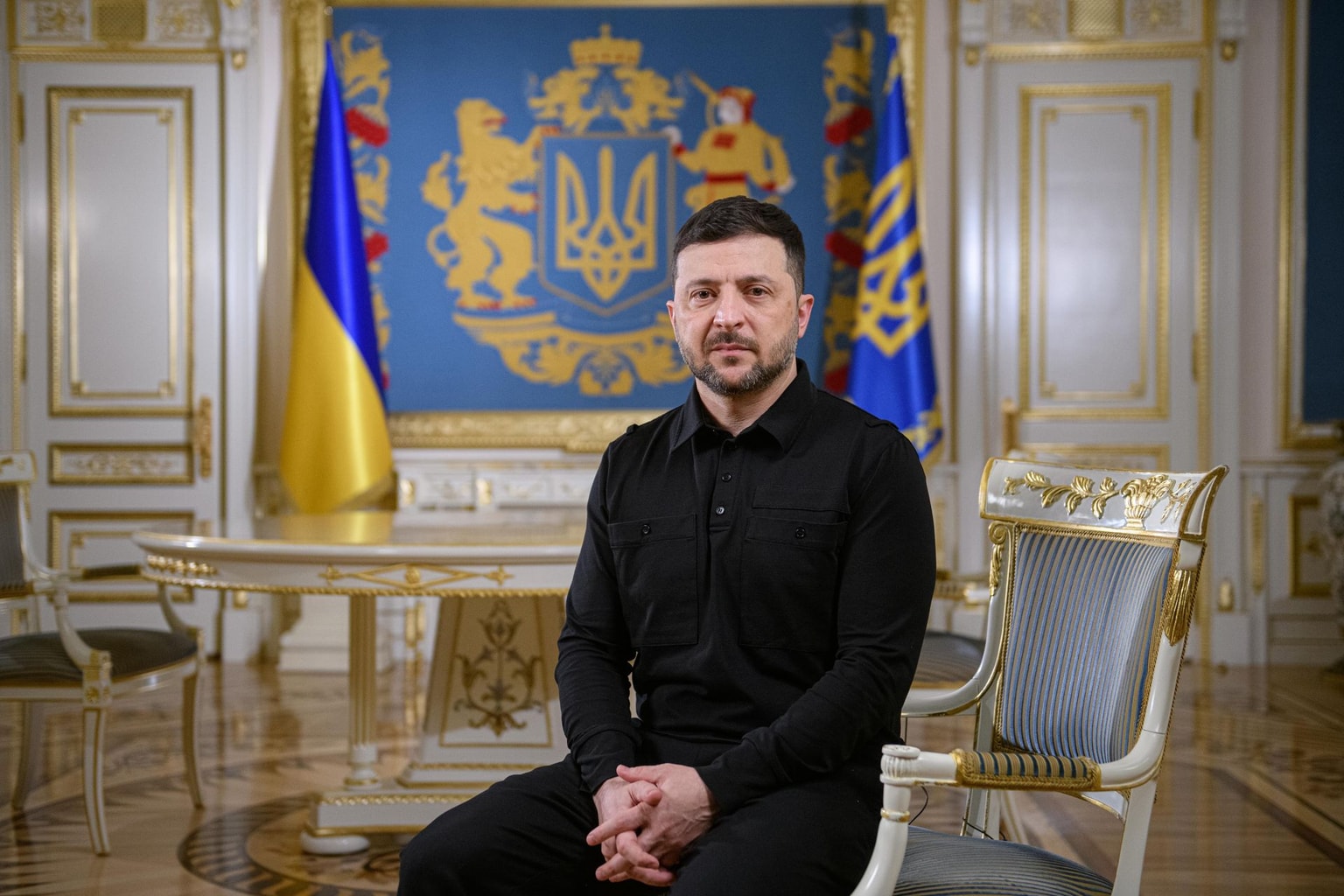
5 ways the New York Times fails its readers in its most recent piece about Russia’s war
A fighter of the Chechen Akhmat battalion walks past destroyed houses in the village of Kazachya Loknya, which was previously held by Ukrainian troops and recently retaken by Russia's armed forces, in the Sudzha district of the Kursk Oblast on March 18, 2025, amid the ongoing Russian-Ukrainian conflict. (Tatyana Makeyeva/AFP via Getty Images)
Editor's Note: This article was updated to include The New York Times' response to the criticism, sent to The Kyiv Independent via email.
The New York Times' recent feature detailing Ukraine's incursion into Russia's Kursk Oblast presents a vivid, harrowing account of civilian suffering.
It also twists the narrative, stays mute on the factors that led to Ukraine's incursion into Russia two and a half years after the start of Russia's all-out war, doesn't mention the civilian toll of the ongoing aggression, legitimizes a terrorist organization, and blames the victim for self-defense.
On July 12, the New York Times published a field report from Russia's Kursk Oblast about the aftermath of Ukraine's seven-month-long incursion. The report titled "A Landscape of Death: What's Left Where Ukraine Invaded Russia" was conducted in cooperation with the notorious Akhmat battalion, the personal army of Chechen warlord Ramzan Kadyrov, sanctioned by the U.S. for torture, repression, and murder.
The battalion is known for committing extrajudicial killings at home and war crimes in Ukraine. None of this is mentioned in the report.
Following the publication of this article and an opinion piece by one of our reporters, The New York Times reached out to The Kyiv Independent with a response to the criticism.
"Our work documenting Russia during its invasion of Ukraine has offered a vital window into a country where reporting has become increasingly dangerous. It’s not propaganda to document the Ukrainian incursions into Kursk, or how the fighting between Ukrainian and Russian forces devastated a community. This story shows the experience of civilians and the consequences they face in war. Our role is to bear witness to the human toll of war and pursue the truth no matter where it leads," The New York Times spokesperson said in a statement sent via email.
In a world where propaganda is having an upper hand, repeating even the most basic facts becomes vital. And when reporting on Russia, a country where the free press was eradicated by President Vladimir Putin's regime, providing the necessary context is a must.
This article failed to do so.
The Kyiv Independent picked five times the author failed to provide due context, and is filling in the gaps.
1. While describing Kursk as a 'place of desolation and death,' the piece fails to mention the exponentially higher civilian casualties in Ukraine at all
The New York Times piece opens up by highlighting that more than 300 civilians have been killed in Russia's Kursk Oblast, according to local authorities, while tens of thousands fled.
But the piece never mentions the thousands of Ukrainians killed during Russia's invasion or the millions of displaced Ukrainians. The United Nations High Commissioner for Human Rights has documented the deaths of at least 13,580 civilians in Ukraine. The actual figures are believed to be much higher, as there is no independent access to the Russian-occupied parts of Ukraine.
During Russia's siege of Mariupol in 2022, it is believed that tens of thousands of civilians were killed by Russian troops.
Civilian casualties in Ukraine continue to rise, as Russia dramatically scales up its air raids across the entirety of Ukraine, even far from the front lines. Last month, civilian casualties reached a three-year high, which the U.N. attributed to Russia's increased use of missiles and drones in urban areas.


2. The piece highlights the suffering of the Akhmat special forces, while failing to mention the battalion has long been accused of serious war crimes in Ukraine
In writing this piece, the author was at times escorted by members of Russia's Chechnya-based Akhmat special forces.
The piece devotes eight paragraphs to describing one of the group's operations in Kursk and the suffering the soldiers experienced as a result.
But this sympathetic portrayal fails to mention that Akhmat forces have been accused of torture, civilian executions, and looting in areas of Ukraine occupied by Russia. For example, the horrific torture, castration, and murder of a Ukrainian POW caught on video in 2022 was carried out by members of the Akhmat battalion, according to an investigation by the open-source group Bellingcat.
The group has also been accused of committing war crimes against Russian forces by intentionally firing on troops who retreat without authorization.
In one anecdote shared with the New York Times, an Akhmat fighter describes wearing blue armbands — Ukrainian colors — to confuse the Ukrainian troops as they advanced in Kursk. The piece describes this as part of a "high-stakes operation" that dealt a "telling blow" to Ukrainian troops as Akhmat troops "fought to reclaim" the region.
Nowhere in the piece does the author inform readers that wearing Ukrainian colors could be a violation of the Geneva Conventions under international rules of war — a fact the Institute for the Study of War pointed out months ago when the operation took place.

Choosing to embed with any military — let alone one repeatedly accused of serious war crimes — carries risks and ethical concerns. Military escorts will often demand to shape or limit what a reporter has access to, which is why when a journalist from the Kyiv Independent visited Kursk with the Ukrainian military, we were transparent with our readers about the questions we faced and how it affected our coverage.
The New York Times did not release any information on how the Akhmat troops shaped their story, which only raises more questions. Were there any guarantees given to the troops? Were they shown any of the text prior to publication? We call on the New York Times to be transparent about any agreement made with the Akhmat troops in exchange for the access provided.

3. The piece repeats debunked Russian propaganda that blames Ukraine for Russia's invasion without any context or pushback
One of the Sudzha residents interviewed for the piece says that a major cause of the war was "NATO expansion," which is described as "reflecting arguments in state media."
Russia has pushed the narrative that NATO expansion is a "root cause" of the war, a view that experts have thoroughly debunked, and one that blames Ukraine for a deadly and destructive invasion that Russia instigated.
NATO expansion was nowhere on Ukraine's popular agenda at the time that Russia first invaded Ukraine in 2014. Russia has also not raised similar resistance when countries it shares a border with have joined NATO.

Instead of providing pushback for this false belief or explaining the true reasons for Russia's invasion, the piece doubles down by adding that many other Russians shared this resident's view.
The same resident describes Ukrainians as "victims of propaganda" because they blame the war on Russian President Vladimir Putin. Many independent experts place responsibility for the invasion on Putin's shoulders. Yet the piece allows her to repeat Russian propaganda with no counter.
4. The headline says 'Ukraine invaded Russia.' The piece never mentions that Russia began an all-out war
The New York Times writes that "Ukraine turned a corner of Russia into a battlefield," and that "Ukraine invaded Russia."
Nowhere does the piece mention that Russia invaded Ukraine first, unprovoked. Or that Ukraine is fighting an existential battle for its survival. Absent from the piece is the context that Ukraine suffered for years on its own territory during the bloodiest land war in Europe since World War II before it entered Kursk.
2014 and 2022 aren't mentioned in the piece at all.


Ukraine's reasons for occupying parts of Kursk Oblast in Russia are almost irrelevant for the New York Times, reduced to being a "bargaining chip for future negotiations" without mentioning why those negotiations are necessary.
While Ukraine is portrayed using the active voice, references to Russia's actions in Ukraine are all described in the passive voice and sanitized of its violent reality. "Large areas of Ukraine still remain occupied by Russia," while Akhmat troops "were used to being treated as occupiers, including in parts of Ukraine that Russia claims as its own," the Times writes.
5. The piece echoes imperialist narratives that link Ukraine and Russia as 'family'
A resident of Kursk interviewed for the article describes the war as "family fighting family."
While there are Russians and Ukrainians who have relatives on both sides of the war, this framing of the war — and the specific decision to compare it to a familial dispute — repeats an imperialist view that Russian propaganda has sought to propagate.
Ukraine and Russia are separate countries, with major linguistic, cultural, and political differences that have developed over hundreds of years.


Occupied for centuries, the Russian Empire attempted to eradicate the Ukrainian nation, banning the Ukrainian language from schools, book publishing, and public life. Repression of Ukrainian language, culture, and history continued during the Soviet Union, when a new narrative was born, one in which Ukrainians and Russians are brothers and are bound to be ruled by Moscow.
The same concept is echoed by the woman interviewed in Sudzha, who says that "everything was one" in the Soviet era, when she moved from Ukraine to Kursk.
In reality, Soviet leadership brutally repressed Ukrainian cultural and linguistic independence when it appeared to threaten Moscow's power, including through executions of Ukrainian cultural figures.
Today, the false idea of Ukraine as a "brotherly nation" is used by Russia to strip Ukraine of its independence and suppress it.










